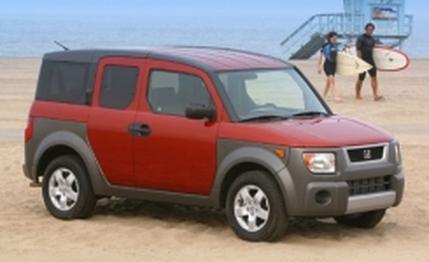
 First Drive Review
First Drive Review
Imagine, if you can, conservative commentator George F. Will shopping for a "club outfit" to wear to a night's revelry at an ecstasy-fueled rave. You may cringe at the sight. You might feel slightly sad. You'd surely want to look away, but you wouldn't be able to take your eyes off the spectacle. (Later, Will would ask random women at the party to touch him "in a meaningful way." His hair would remain perfect.)
As close as we can estimate, this is what it feels like to get the marketing pitch for Honda's funky new box, the Element.
Until now, Honda hasn't trotted out the "young and active" psychographic/demographic spiel as GM did with the Pontiac Aztek, Nissan did with the Xterra, and Toyota is about to do with its Scion brand. The sober, engineering-minded Honda was never the company to dress its executives in black leather and hire actors to simulate a mosh pit at its press conferences.
It wasn't Honda's thing until the company noticed that the average Civic buyer is getting older and that Civics are increasingly sold to women. Despite record sales for Honda, this sort of thing keeps marketers up at night.
So here, then, is the Element. Based heavily on the Honda CR-V, it's a vehicle conceived and designed specifically to attract 22-year-old men with "many friends" and a lifestyle so active you and I would need amphetamines just to keep up. Oh, and they likely won't have jobs, according to Honda.
Like the Pontiac Aztek's, the reasoning behind the Element's existence carries the whiff of patronizing cynicism. Unlike that egregious-looking machine, the resulting Honda is quite a good little vehicle.
In fact, if you can get your head around the cubic styling (which Honda believes is masculine), the Element might just suit your tastes better than a CR-V.
Although it's smaller than a CR-V (it's a foot stubbier in overall length), the Element feels roomier inside. It's an illusion of the Element's proportions. It stands almost eight inches taller than a CR-V. With the roof towering above and the A-pillars off in the distance, the view from the cockpit is not unlike that from the VW New Beetle wheelhouse.
But there's another trick at play here. It's the product of the Element's signature feature: side doors that open like clamshells. Open both doors on a side (the rear doors open 90 degrees to the body), and with no B-pillar bisecting the access, the interior space at least looks cavernous. The rear seats are mounted relatively far back, so rear-passenger legroom doesn't suffer, but cargo space does.
To achieve the B-pillarless sides, Honda beefed up the structure around this large hole, including bigger rocker panels and reinforced joints. According to Honda, the structural rigidity is on par with the CR-V's. The downside is that the additional structure adds weight. According to Honda's scales, an Element EX with four-wheel drive and a five-speed manual transmission weighs 3550 pounds, or roughly 250 more than a similarly equipped CR-V.
Powered by a 160-hp, 2.4-liter DOHC in-line four that's almost identical to the engine in the base-level 2003 Accord and CR-V, the Element doesn't move out with much authority. Honda has shortened the gearing compared with that of the CR-V, in both the five-speed manual and the optional four-speed automatic, in an attempt to keep the Element reasonably quick. Thus, the Element is quicker than most garbage trucks and skyscrapers-figure a 0-to-60-mph run of about 10 seconds for a loaded four-wheel-drive version. The extra weight also impacts fuel economy-the Element will go about two fewer miles per gallon than the CR-V.